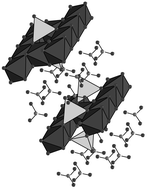Abstract
Layered Ni,Zn hydroxyacetates have been prepared by hydrothermal methods and have been used for anion exchange of the original acetate anions by chloride, bromide, carbonate, nitrate, sulfate, and phosphate. Exchange was complete in all cases. The solids have been characterised by elemental chemical analysis, powder X-ray diffraction, thermal analysis (thermogravimetric and differential), FT-IR spectroscopy and electron microscopy; XAS spectra were also recorded in some cases. Thermal decomposition in air leads to removal of interlayer water at 150–200 °C. Mixed NiO–ZnO oxides are formed at higher temperatures. Chloride, sulfate, and phosphate salts are also formed at intermediate calcination temperature, and phosphate remains even after calcination at 1000 °C.


 Please wait while we load your content...
Please wait while we load your content...